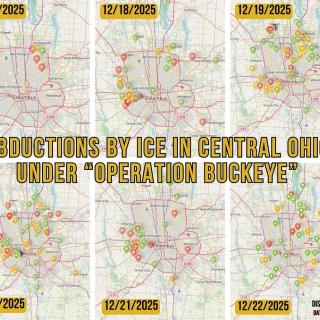Advertisement
Ten years ago, then-26-year-old songwriter John Rohrer, troubled about loss of a recent job, was experiencing a delayed reaction to a street hallucinogen he had tried. Dazed, he went to visit a friend but entered the wrong house to wait for her. When the true owner returned to the unlocked house, he was not sympathetic as Rohrer tried to explain his confusion and leave.
Rohrer waited while police were called to arrest him. Ross County prosecutors soon swung into action, charging Rohrer with felony burglary, although no offense had been committed other than the entry. For some two years Ross County prosecutors pushed for incarceration for this first offense.
In June 2008, with no one understanding at the time that the offense was drug related, Rohrer was persuaded to enter a plea of NGRI – “not guilty by reason of insanity.” To Rohrer, who was terrified of the penitentiary, it seemed the only way. Ten years later he understands how this became his initiation into indefinite psychiatric lockup.
Ross County Judge William Corzine, assigned to the “burglary”/trespass case, ordered Rohrer to be supervised by Scioto Paint Valley Mental Health Board (SPVMHB), which placed him at the violence-plagued Detillion home in Chillicothe in June 2008. SPVMHB psychiatrist Ellen Ballerene drugged Rohrer from the beginning with an assortment of SSRI and neuroleptic drugs including Celexa, Invega, Neurontin, and Buspar, and did so “apparently on the basis of trial and error, without consideration of drug interactions” (p. 8, Sept. 2014 report to Ross County court), according to John’s longtime M. D., Dr. Sandra Pinkham, a published toxicologist who reviewed the records years later.
By July 2009, struggling to adjust to the drugs and odd feelings of anger, Rohrer began asking Ballerene whether the drugs could induce violence. Although she documented his concerns in his medication records she kept prescribing the drugs anyway. Rohrer asked his SPVMHB case manager for a transfer due to the home’s violence but was told basically to “deal with it.”
On September 1, 2009, still drugged and freshly bleeding from injuries to his head and body inflicted by an unidentified assailant, Rohrer struck another resident, a man who had previously attacked him and who had been grabbing at Rohrer’s pants that day. Rohrer immediately asked that police be called to sort out what had happened and who was at fault. Police arrived but tasered him, and took him to the Ross County jail where he was further battered – another experience in state-sponsored atrocities he described later in an affidavit: “I was stripped and given a thinner-than-gauze, yellow, open in the back, ‘suicide gown’ to wear while trapped in a small room for a month and a half, filled at times with sexual predators and one severely ill, seemingly dying individual.” (Ex. XXII, Ohio Sup. Court Case No. 2014-0268).
Charged with felonious assault Rohrer once again entered a plea of NGRI, in January, 2010. Although Ohio law and constitutional principles require a separate hearing to determine whether an NGRI offender is “mentally ill” and imminently dangerous at the time of the commitment hearing, Rohrer was not provided a hearing in which any evidence was admitted nor was he informed he had the right to liberty unless the State proved by clear and convincing evidence that he was “mentally ill” and imminently “dangerous” at the time of that required hearing. As his subsequent attorney, David Kastner, explained in a 2014 civil suit still pending in Ohio’s Court of Claims, Judge Corzine in 2010 not only refused to permit the hearing required by Ohio Rev. Code Sec. 2945.40, but he joined with the prosecutor and the public defender to actively conceal Rohrer’s rights from him, and did so fraudulently. http://cases.ohiocourtofclaims.gov/cgi-bin/wspd_cgi.sh/streamfile.p?Serial=141125001370501&Seq=1 [Parag. 99]
Since he was not told of his rights and didn’t waive any, Rohrer was misled to believe that by entering the plea of NGRI he would be entitled to no separate commitment hearing and would automatically be dealt with by OMHAS, the state’s mental illness system. But the State may not constitutionally confine a citizen psychiatrically at all unless clear and convincing evidence proves him both “mentally ill” and “dangerous” at time of hearing. Foucha v. Louisiana 504 U.S. 71 (1992);Addington v. Texas 441 U.S. 418 (1979).
Without further ado, Corzine sent Rohrer off to the State hospital – Twin Valley Behavioral Healthcare for “treatment”. Rohrer describes it as somewhat less violent than the Ross County jail. One of his first memories of Twin Valley is of Dr. David Soehner, a psychiatrist he refers to as a particularly “cold” man who “ought to be in a different line of work”. Soehner told a group of patients: ‘This disease will take away a third of your life.’ In fact, even if there were an objective way to diagnose mental “disease”, and Dr. Jean Scott of OMHAS admitted under oath in 2014 that there is none, significant scientific literature shows it is the psychotropic drugging, not “the disease” that kills and sickens psychiatric patients. http://psychrights.org/litigation/WhitakerAffidavit.pdf
BUT DON’T THE DRUGS MAKE PEOPLE LESS VIOLENT?
According to the International Society for Ethical Psychology and Psychiatry, various factors are associated with violence but none of them can actually predict violence. The only variables consistently associated with violence are drugs and alcohol. Any drugs. In its amicus curiae brief in the John Rohrer case, the ISEPP attorney explained that
“Having a diagnosis of mental illness is not a risk factor.” [p. 10, ISEPP Brief, State v.Rohrer, Ross County Case No.09 CR 393]
Psychiatry itself is unusually incapable of predicting violence as the American Psychiatric Association admitted in its brief to the U.S. Supreme Court:
“two out of three predictions of long-term future dangerousness made by psychiatrists are wrong”.Barefoot v. Estelle, 463 U.S. 880, 920 (1983)
There appears to be no role even claimed for psychotropic drugs in reducing violence, except as a chemical straitjacket. On the contrary, most ssri (antidepressant) drugs induce not only violence against others but also against self. In measuring the violence inducing effects established in a 2011 Harvard study, which excluded self-harming behaviors, Dr. Gary Kohls notes that any drug from the study’s exhaustive list may “pose a significant threat to society in that irrational, out-of-character behaviors can result”. http://duluthreader.com/articles/2012/04/05/299_many_psychoactive_drugs_are_strongly_associated. The corporate media refuses to track the violence, but ssri drug violence is well documented atwww.ssristories.org.
Dr. W. Neil Gowensmith’s 2014 study of NGRI acquittees in 4 states http://app.leg.wa.gov/ReportsToTheLegislature/Home/GetPDF?fileName=SSB%205732%20Forensic%20Mental%20Health%20-%20Consultant%20Review%208-1-14_f0bf65c7-0048-489f-be25-6e01c89be4a0.pdf found that the rates of violent recidivism for this population
“are lower than violence rates in the general population.” [p. 46]
OMHAS PREFERS USING COERCION – BUT FORCE WORKS TOO
A 2013 OMHAS training tutorial describes how it coaches its employees in techniques for coercing patients to submit to psychiatric drugging. http://mha.ohio.gov/Portals/0/assets/Initiatives/Public-Private/Court%20Ordered%20Medication%20Processes%2010%2024%202013%20Final%20Draft2.pdf. Without the coercion, the drugs’ effects are so harsh few would submit to them. OMHAS tutorial authors Hurst and Baumgarten describe an incremental psychological assault on the will of the patient using “persuasion” – rationalizing to employees that there is only a “subtle difference between ‘persuasion’ and ‘coercion’” and that “persuasion” is acceptable – part of the job.
However, OMHAS coercion was ineffective when applied to Rohrer at Twin Valley, because, especially after he was taken off the ssri drug Celexa, he felt he was doing well on only 1/3 of the levels of other drugs Dr. Soehner wanted him to take. But Soehner could not tolerate any disagreement and seems to have written to Judge Corzine. The transcript from March 4, 2011 forced drugging proceedings before Corzine in Ross County again shows no evidence or testimony was admitted except that Rohrer was permitted to speak this time. Maintaining his composure despite a sleepless night in the jail the night before, Rohrer explained his reasons for wanting to take a lower level of the drugs Soehner was pushing:“”This is Twin Valley we’re dealing with, so it’s not like I’m going to have a chance . . . a snow ball’s chance in hell of changing the court’s decision on this matter, but I just wanted to state my view and try to get you to see my humanity I guess.”
Although Corzine commented that “you appear pretty lucid today” and despite the absence of any testimony or documentary evidence to the contrary, Corzine purported to order forced drugging. To do that he had to disregard the leading Ohio case on forced drugging, Steele v. Hamilton County 90 Ohio St3d 176 (2000), in which the Ohio Supreme Court held that a court may not order forced drugging as a course of treatment without a finding that the person lacks the “capacity” to consent. Corzine made no such finding but signed a forced drugging “Entry” just the same. That “Entry” would work irreversible emotional and neurological damage on Rohrer over the next 3 years and 7 months, until Judge Holzapfel listened to Dr. Gregory Janson’s 9/25/14 testimony urging him to stop it.
Somehow during the degrading forced drugging years, Rohrer managed to rally his emotional and spiritual strength enough to deal with drug-induced stupor and bizarre feelings of horror [known as akathisia] and to continue his writing, self-publishing, and musical recordings while at Twin Valley, and during much of his time at Appalachian Behavioral Healthcare [ABH]. ABH cut off his internet access in 2014 when Rohrer’s websites inspired too many supporters who made calls to ABH management that it didn’t like. Rohrer remains locked up at ABH, as a person said to be civilly as opposed to criminally committed. In the last few years there, Rohrer took himself gradually off those drugs that ABH permitted him to go off of, bearing the agonies of benzodiazepine withdrawal with little if any medical help. There are some 6 documented instances at both facilities where he was physically attacked but refused to defend himself, in a further effort to prove himself “non-violent” to his captors. But there are no plans to release him.
During a brief 2007 exposure to Risperdal, Rohrer had suffered a cardiac event, but this did not stop it from being chosen as the primary drug to force inject. Soon his records would reflect that he suffered mitral valve prolapse and some sort of “Tourette” type of “epilepsy”, despite having no history of either. Neuroleptic drugs such as Risperdal cause tardive dyskinesia, a neurological disorder caused only by the drugs. Early t.d. can appear to be a form of epilepsy, palsy, or Parkinsonism. In its most severe forms, t.d. can make speech and walking impossible. According to a letter Dr. Sandra Pinkham sent to Rohrer on 4/30/14, she warned about ABH’s refusal to taper the Risperdal to “prevent worsening tardive dyskinesia”’ and observed that Twin Valley doctors had also
“tried a disastrous experiment with escalating doses of clozapine that really put his life in danger. I can find no justification for ABH to adhere rigidly to this old protocol”.
ABH, Judge Holzapfel, and the Ohio Supreme Court all ignored her warnings. ABH continued its practice of identifying adverse drug reactions (ADR’s) not as the ADR’s that they are, but as unrelated “medical conditions” - conveniently exculpating the drug. Paradoxically Risperdal, while causing t.d., also masks the damage it does - until that damage become so pronounced that nothing masks it. The longer the drugging, the more intractable the damage. Even the FDA recommends Risperdal use for no longer than 3 weeks. http://www.accessdata.fda.gov/drugsatfda_docs/label/2009/020272s056,020588s044,021346s033,021444s03lbl.pdf [p. 7]
The full extent of the drug damage done is not yet known, since ABH and Judge Holzapfel effectively deny Rohrer full access to his own physicians. John’s attorney filed legal and medical malpractice actions in 2014 against some 20+ state actors and several state agencies. The State of Ohio has not to date specifically disputed Rohrer’s allegations in that case, but instead files motions to prevent the facts from reaching a factfinder.
In spite of dire predictions from ABH psychiatrist Anthony Derrico that Rohrer would “decompensate” if allowed to choose his own level of drugging, nothing of the kind has occurred. Now taking an oral form of Risperdal at a level so low it cannot be detected in his blood, he is described by a few unusually candid ABH employees in very different terms in his November, 2015 chart: “asymptomatic” with “no symptoms of psychosis noted” according to Trisha McVey. Emily M. Marcus noted: “patient is functioning well on the unit”. Vicky L. Erdy RN wrote: “Objectively he presents as pleasant and cooperative, he remained engaged throughout this evaluation. John continues to have fluent and articulate speech with appropriate responses to conversation. His thoughts are organized and future oriented.”
Although Ross county prosecutor Jeff Marks has basically conceded that he has no current evidence to justify Rohrer’s lockup, he refuses without explanation to consider agreeing with the 20+ affidavits from Rohrer’s supporters or the mountain of evidence from Rohrer’s experts that say he should be released unconditionally.
WHY ARE TAXPAYERS SUPPORTING A COURT/PSYCHIATRY PARTNERSHIP TO TREAT THOSE WHO ARE “ASYMPTOMATIC”?
OMHAS openly partners with convicted drug makers such as Jansen Pharmaceuticals (the makers of RIsperdal). Two former heads of OMHAS, Dr. Dale Svendson and Dr. Michael Hogan, are long-time promoters of the Jansen Pharmaceutical marketing agenda through the OMHAS system of which ABH is a part. The Ohio Attorney General’s office pockets millions from fines when Jansen and other drug makers plead guilty to fraudulently marketing the non-existent benefits of their wares to state hospitals while those damaged by these drugs receive nothing and the State’s prescribers continue as before. Despite being charged by law with investigating patient abuse and Medicare fraud in state hospitals, the Ohio Attorney General refuses to investigate the patient abuse John’s family reported to its MFCU in 2014. Instead it defends state hospitals charged with illegalities.
The Ohio Supreme Court has recently been discovered in a long-term alliance not only with OMHAS but also one Cardwell C. Nuckols, a convicted Medicaid/Medicare kickback perpetrator. US v. Nuckols, Case No. 1:01-cr-00525 (ND ED Ohio 2001). Dr. Nuckols’ role with the high Court is said to be to instruct Ohio judges about “the new standard for diagnosing individuals with psychiatric disorders”. [emphasis supplied] http://www.courtnewsohio.gov/CNOReview/2014/January2014.pdf [p. 4] as the high Court rolls out its “Specialized Dockets” program.
The thousands of dollars per day costs to hospitalize one patient are guaranteed with NGRI acquitee patients. On the few occasions in which an OMHAS hospital releases a forensic (NGRI) patient, it does everything possible to make sure that the release is conditional and on OMHAS terms, which means maintaining an income stream to a local OMHAS controlled county Mental Health board. Sometimes this means that OMHAS finds that a man who stabbed his father 50 times but agrees to staydrugged is “low risk” and ready to be sent back into the community http://woub.org/2015/05/24/man-who-killed-father-granted-unsupervised-leave-from-mental-hospital/. Judge Holzapfel seems to agree with this logic for the cooperative Jonathan Bebb but refuses to allow the sometimes dissident John Rohrer even a statutorily mandated review hearing.
Conditional release for Rohrer would mean being sent back to a violent Ross County group home run by SPVMHB, but more billings for the OMHAS system. Mr. and Mrs. Rick Geddes, who have their own SPVMHB horror story, report that during 2014 and 2015:
“[w]e found records showing Mary Preston of SPVMHB was billing for counseling services she never rendered.”
John’s supporters do not believe Rohrer would be safe living in Ross County if he ever were to be released.
GROWING RESISTANCE TO PSYCHIATRY
The Law Project for Psychiatric Rights is an advocacy group for those who are losing their liberties to the psychiatry/court partnership. Founded by psychiatric survivor and attorney, James Gottstein, it sometimes files amicus curiae briefs as it did in Rohrer’s case. Other organizations include Mind Freedom, which issues alerts, and Mad in America, Robert Whitaker’s organization, which provides an open forum for articles. NAMI, though better known than these, cannot be considered an advocacy organization for those labeled “mentally ill” because it is a drug company front group that only portrays itself as acting in the interests of those with a mental illness label. It passionately supports the notorious Murphy bill, the newest federal threat to constitutional rights, just as NAMI’s Ohio chapter supported Governor Kasich’s Medicaid expansion that forces taxpayers to fund more forced psychiatry in Ohio. Online petitions to stop the latest version of the Murphy bill can be found at https://www.wljaradio.net/bedlam-in-america.html where readers may also hear weekly broadcasts of this writer’s Ohio-based talk show, Bedlam in America, and hear updates on efforts to FreeJohnRohrer.



